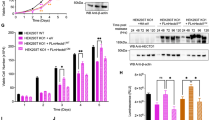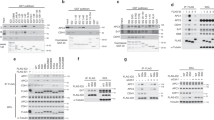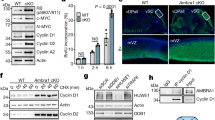Abstract
Emi1 promotes mitotic entry in Xenopus laevis embryos by inhibiting the APCCdc20 ubiquitination complex to allow accumulation of cyclin B. We show here that human Emi1 (hEmi1) functions to promote cyclin A accumulation and S phase entry in somatic cells by inhibiting the APCCdh1 complex. At the G1–S transition, hEmi1 is transcriptionally induced by the E2F transcription factor, much like cyclin A. hEmi1 overexpression accelerates S phase entry and can override a G1 block caused by overexpression of Cdh1 or the E2F-inhibitor p105 retinoblastoma protein (pRb). Depleting cells of hEmi1 through RNA interference prevents accumulation of cyclin A and inhibits S phase entry. These data suggest that E2F can activate both transcription of cyclin A and the hEmi1-dependent stabilization of APCCdh1 targets, such as cyclin A, to promote S phase entry.
This is a preview of subscription content, access via your institution
Access options
Subscribe to this journal
Receive 12 print issues and online access
$209.00 per year
only $17.42 per issue
Buy this article
- Purchase on Springer Link
- Instant access to full article PDF
Prices may be subject to local taxes which are calculated during checkout







Similar content being viewed by others
References
Minshull, J., Blow, J. J. & Hunt, T. Translation of cyclin mRNA is necessary for extracts of activated Xenopus eggs to enter mitosis. Cell 56, 947–756 (1989).
Murray, A. W. & Kirschner, M. W. Cyclin synthesis drives the early embryonic cell cycle. Nature 339, 275–280 (1989).
Meijer, L. et al. Cyclin is a component of the sea urchin egg M-phase specific histone H1 kinase. EMBO J. 8, 2275–2282 (1989).
den Elzen, N. & Pines, J. Cyclin A is destroyed in prometaphase and can delay chromosome alignment and anaphase. J. Cell Biol. 153, 121–136 (2001).
Geley, S. et al. Anaphase-promoting complex/cyclosome-dependent proteolysis of human cyclin A starts at the beginning of mitosis and is not subject to the spindle assembly checkpoint. J. Cell Biol. 153, 137–148 (2001).
King, R. W. et al. A 20S complex containing CDC27 and CDC16 catalyzes the mitosis-specific conjugation of ubiquitin to cyclin B. Cell 81, 279–288 (1995).
Jackson, P. K. et al. The lore of the RINGs: substrate recognition and catalysis by ubiquitin ligases. Trends Cell Biol. 10, 429–439 (2000).
Zachariae, W. & Nasmyth, K. Whose end is destruction: cell division and the anaphase-promoting complex. Genes Dev. 13, 2039–2058 (1999).
Visintin, R., Prinz, S. & Amon, A. CDC20 and CDH1: a family of substrate-specific activators of APC- dependent proteolysis. Science 278, 460–463 (1997).
Shirayama, M., Toth, A., Galova, M. & Nasmyth, K. APC(Cdc20) promotes exit from mitosis by destroying the anaphase inhibitor Pds1 and cyclin Clb5. Nature 402, 203–207 (1999).
Fang, G., Yu, H. & Kirschner, M. W. Direct binding of CDC20 protein family members activates the anaphase- promoting complex in mitosis and G1. Mol. Cell 2, 163–171 (1998).
Sigrist, S. J. & Lehner, C. F. Drosophila fizzy-related down-regulates mitotic cyclins and is required for cell proliferation arrest and entry into endocycles. Cell 90, 671–681 (1997).
Zachariae, W., Schwab, M., Nasmyth, K. & Seufert, W. Control of cyclin ubiquitination by CDK-regulated binding of Hct1 to the anaphase promoting complex. Science 282, 1721–1724 (1998).
Kramer, E. R., Gieffers, C., Holzl, G., Hengstschlager, M. & Peters, J. M. Activation of the human anaphase-promoting complex by proteins of the CDC20/Fizzy family. Curr. Biol. 8, 1207–1210 (1998).
Lorca, T. et al. Fizzy is required for activation of the APC/cyclosome in Xenopus egg extracts. EMBO J. 17, 3565–3575 (1998).
Shah, J. V. & Cleveland, D. W. Waiting for anaphase: Mad2 and the spindle assembly checkpoint. Cell 103, 997–1000 (2000).
Pfleger, C. M., Salic, A., Lee, E. & Kirschner, M. W. Inhibition of Cdh1-APC by the MAD2-related protein MAD2L2: a novel mechanism for regulating Cdh1. Genes Dev. 15, 1759–1764 (2001).
Chen, J. & Fang, G. MAD2B is an inhibitor of the anaphase-promoting complex. Genes Dev. 15, 1765–1770 (2001).
Reimann, J. D. et al. Emi1 Is a Mitotic Regulator that Interfunctions with Cdc20 and Inhibits the Anaphase Promoting Complex. Cell 105, 645–655 (2001).
Reimann, J. D. R., Gardner, B. E., Margottin-Goguet, F. & Jackson, P. K. Emi1 regulates the anaphase-promoting complex by a different mechanism than Mad2 proteins. Genes Dev. 15, 3278–3285 (2001).
Harbour, J. W. & Dean, D. C. The Rb/E2F pathway: expanding roles and emerging paradigms. Genes Dev. 14, 2393–2409 (2000).
Lukas, C. et al. Accumulation of cyclin B1 requires E2F and cyclin-A-dependent rearrangement of the anaphase-promoting complex. Nature 401, 815–818 (1999).
Girard, F., Strausfeld, U., Fernandez, A. & Lamb, N. J. Cyclin A is required for the onset of DNA replication in mammalian fibroblasts. Cell 67, 1169–1179 (1991).
Pagano, M., Draetta, G. & Jansen-Durr, P. Association of cdk2 kinase with the transcription factor E2F during S phase. Science 255, 1144–1147 (1992).
Waizenegger, I. C., Hauf, S., Meinke, A. & Peters, J. M. Two distinct pathways remove mammalian cohesin from chromosome arms in prophase and from centromeres in anaphase. Cell 103, 399–410 (2000).
Kramer, E. R., Scheuringer, N., Podtelejnikov, A. V., Mann, M. & Peters, J. M. Mitotic regulation of the APC activator proteins CDC20 and CDH1. Mol. Biol. Cell 11, 1555–1569 (2000).
Lukas, J. et al. Cyclin E-induced S phase without activation of the pRb/E2F pathway. Genes Dev. 11, 1479–1492 (1997).
Moroni, M. C. et al. Apaf-1 is a transcriptional target for E2F and p53. Nature Cell Biol. 3, 552–558 (2001).
Pagano, M., Pepperkok, R., Verde, F., Ansorge, W. & Draetta, G. Cyclin A is required at two points in the human cell cycle. EMBO J. 11, 961–971 (1992).
Resnitzky, D., Hengst, L. & Reed, S. I. Cyclin A-associated kinase activity is rate limiting for entrance into S phase and is negatively regulated in G1 by p27Kip1. Mol. Cell. Biol. 15, 4347–4352 (1995).
Sorensen, C. S. et al. Nonperiodic activity of the human anaphase-promoting complex-Cdh1 ubiquitin ligase results in continuous DNA synthesis uncoupled from mitosis. Mol. Cell Biol. 20, 7613–7623 (2000).
Elbashir, S. M. et al. Duplexes of 21-nucleotide RNAs mediate RNA interference in cultured mammalian cells. Nature 411, 494–498 (2001).
Petersen, B. O. et al. Cell cycle- and cell growth-regulated proteolysis of mammalian CDC6 is dependent on APC-CDH1. Genes Dev. 14, 2330–2343 (2000).
Furstenthal, L., Swanson, C., Kaiser, B. K., Eldridge, A. G. & Jackson, P. K. Triggering ubiquitination of a CDK inhibitor at origins of DNA replication. Nature Cell Biol. 3, 715–722 (2001).
Sorensen, C. S. et al. A conserved cyclin-binding domain determines functional interplay between anaphase-promoting complex–Cdh1 and Cyclin A–Cdk2 during cell cycle progression. Mol. Cell. Biol. 21, 3692–3703 (2001).
Grosskortenhaus, R. & Sprenger, F. Rca1 inhibits APC–Cdh1(Fzr) and is required to prevent cyclin degradation in G2. Dev. Cell 2, 29–40 (2002).
Dong, X. et al. Control of G1 in the developing Drosophila eye: rca1 regulates Cyclin A. Genes Dev. 11, 94–105 (1997).
Sprenger, F., Yakubovich, N. & O'Farrell, P. H. S-phase function of Drosophila cyclin A and its downregulation in G1 phase. Curr. Biol. 7, 488–499 (1997).
Lehner, C. F. & O'Farrell, P. H. The roles of Drosophila cyclins A and B in mitotic control. Cell 61, 535–547 (1990).
Vidwans, S. J. & Su, T. T. Cycling through development in Drosophila and other metazoa. Nature Cell Biol. 3, E35–E39 (2001).
Wu, L. et al. The E2F1-3 transcription factors are essential for cellular proliferation. Nature 414, 457–462 (2001).
Leone, G. et al. E2F3 activity is regulated during the cell cycle and is required for the induction of S phase. Genes Dev. 12, 2120–2130 (1998).
Sudo, T. et al. Activation of Cdh1-dependent APC is required for G(1) cell cycle arrest and DNA damage-induced G(2) checkpoint in vertebrate cells. EMBO J. 20, 6499–6508 (2001).
van 't Veer, L. J. et al. Gene expression profiling predicts clinical outcome of breast cancer. Nature 415, 530–536 (2002).
Cenciarelli, C. et al. Identification of a family of human F-box proteins. Curr. Biol. 9, 1177–1179 (1999).
Muller, H. et al. E2Fs regulate the expression of genes involved in differentiation, development, proliferation, and apoptosis. Genes Dev. 15, 267–285 (2001).
Koepp, D. M. et al. Phosphorylation-dependent ubiquitination of cyclin E by the SCFFbw7 ubiquitin ligase. Science 294, 173–177 (2001).
Cortez, D., Guntuku, S., Qin, J. & Elledge, S. J. ATR and ATRIP: Partners in Checkpoint Signaling. Science 294, 1713–1716 (2001).
Acknowledgements
The authors would like to thank T. Wang, J. Peters, T. Hunt, M. Pagano, L. Furstenthal, A. Eldridge, A. Salic, K. Helin, and Clontech for providing important reagents, C. Crumpton for flow cytometric sorting and analysis, A. Bogale for assistance in cell culture, C. Lukas for microinjection experiments, A. Eldridge for critical reading of the manuscript, J. Chao for the TFSEARCH referral, and K. Helin, F. Sprenger, and T. Tuschl for communicating unpublished results. This research is supported by a Cancer Biology Training Grant CA09302 and a Howard Hughes Medical Institute Predoctoral Fellowship to J.Y.H., a National Institute of General Medical Sciences Medical Scientist Training Grant GM07365 to J.D.R.R., the Danish Cancer Society and the Danish Medical Research Council to C.S.S. and J.L., and National Institutes of Health grants GM54811 and GM60439 to P.K.J.
Author information
Authors and Affiliations
Corresponding author
Supplementary information
Figure S1 Sequence and E2F consensus sites of the hEmi1 promoter.
Figure S2 hEmi1 transcripts are upregulated in various tumors. (PDF 303 kb)
Rights and permissions
About this article
Cite this article
Hsu, J., Reimann, J., Sørensen, C. et al. E2F-dependent accumulation of hEmi1 regulates S phase entry by inhibiting APCCdh1. Nat Cell Biol 4, 358–366 (2002). https://doi.org/10.1038/ncb785
Received:
Revised:
Accepted:
Published:
Issue Date:
DOI: https://doi.org/10.1038/ncb785
This article is cited by
-
A fast-acting lipid checkpoint in G1 prevents mitotic defects
Nature Communications (2024)
-
Effect of Emi1 gene silencing on the proliferation and invasion of human breast cancer cells
BMC Molecular and Cell Biology (2023)
-
Systematic analysis of the expression and prognosis relevance of FBXO family reveals the significance of FBXO1 in human breast cancer
Cancer Cell International (2021)
-
The Evi5 oncogene promotes laryngeal cancer cells proliferation by stabilizing c-Myc protein
Cancer Cell International (2020)
-
Altered G1 signaling order and commitment point in cells proliferating without CDK4/6 activity
Nature Communications (2020)



